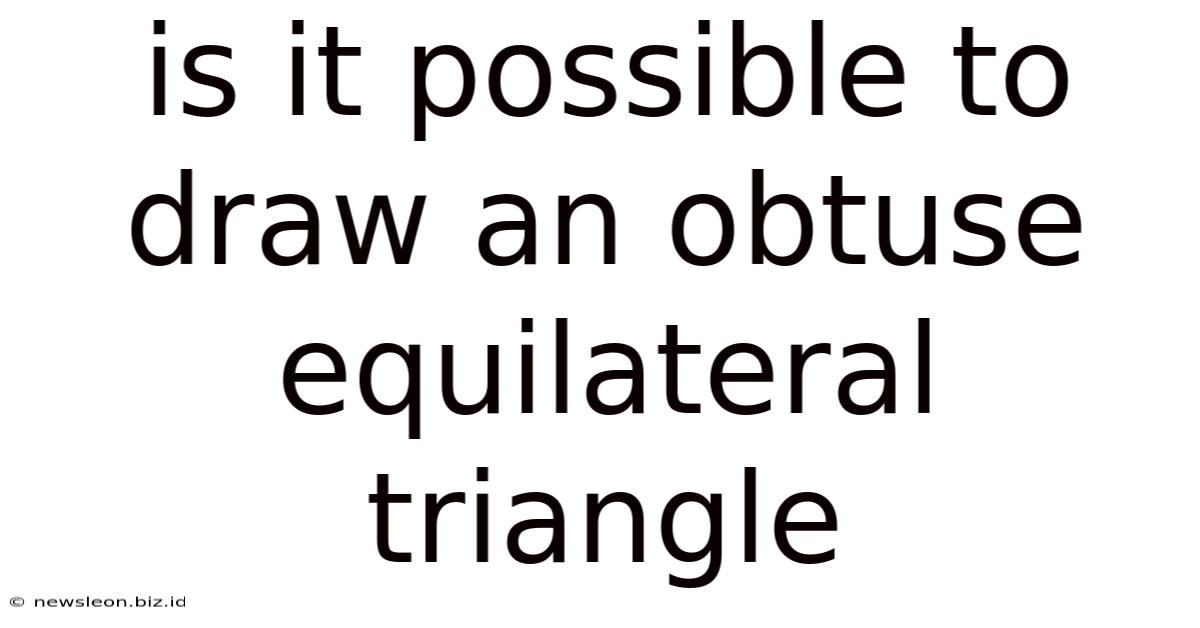Is It Possible To Draw An Obtuse Equilateral Triangle
News Leon
May 04, 2025 · 4 min read

Table of Contents
Is It Possible to Draw an Obtuse Equilateral Triangle? A Deep Dive into Geometry
The question, "Is it possible to draw an obtuse equilateral triangle?" might seem straightforward at first glance. The answer, however, requires a deeper understanding of the fundamental properties of triangles, specifically focusing on the definitions of equilateral and obtuse. This exploration will delve into the geometrical principles that definitively answer this question, clarifying any potential misconceptions. We'll examine the angle properties of triangles and demonstrate why the coexistence of "equilateral" and "obtuse" within a single triangle is geometrically impossible.
Understanding the Definitions: Equilateral and Obtuse
Before we attempt to answer the central question, let's clearly define the key terms:
-
Equilateral Triangle: An equilateral triangle is a polygon with three equal sides and, critically, three equal angles. Each angle in an equilateral triangle measures 60 degrees (180 degrees / 3 sides = 60 degrees). This is a defining characteristic; without equal angles, a triangle cannot be classified as equilateral.
-
Obtuse Triangle: An obtuse triangle is a triangle with one obtuse angle. An obtuse angle is an angle that measures greater than 90 degrees but less than 180 degrees. The presence of a single obtuse angle automatically means the other two angles must be acute (less than 90 degrees).
The Internal Angle Sum of a Triangle: A Crucial Property
A fundamental theorem in geometry states that the sum of the internal angles of any triangle always equals 180 degrees. This is a cornerstone of Euclidean geometry and applies universally to all types of triangles, regardless of their side lengths or angle measures. This simple rule holds the key to understanding why an obtuse equilateral triangle is impossible.
The Contradiction: Equilateral vs. Obtuse
Let's assume, for the sake of contradiction, that an obtuse equilateral triangle exists. If it were equilateral, all three angles would measure 60 degrees (as established above). However, if it were also obtuse, it would necessarily contain at least one angle greater than 90 degrees. This creates an immediate and irreconcilable contradiction:
- Equilateral property: All angles are 60 degrees.
- Obtuse property: At least one angle is greater than 90 degrees.
These two properties are mutually exclusive. A triangle cannot simultaneously possess all angles equal to 60 degrees and have one angle exceeding 90 degrees. The sum of angles in our hypothetical triangle would exceed 180 degrees, violating the fundamental rule of triangle angle summation.
Visualizing the Impossibility
Trying to visualize an obtuse equilateral triangle is inherently challenging. Imagine attempting to draw three equal-length sides connected to form a triangle. No matter how you arrange the sides, you'll inevitably find that the angles formed will always be 60 degrees. You simply cannot create an angle larger than 90 degrees while maintaining the equal side lengths characteristic of an equilateral triangle.
Exploring Related Concepts: Types of Triangles
Understanding the limitations of an obtuse equilateral triangle requires exploring the broader classification of triangles based on their angles:
- Acute Triangle: All angles are less than 90 degrees.
- Right Triangle: One angle is exactly 90 degrees.
- Obtuse Triangle: One angle is greater than 90 degrees.
Equilateral triangles always fall into the category of acute triangles because their angles are all 60 degrees. This classification further reinforces the impossibility of an obtuse equilateral triangle.
The Role of Euclidean Geometry
The conclusion that an obtuse equilateral triangle is impossible is firmly rooted within the framework of Euclidean geometry. This system of geometry, based on Euclid's postulates, governs the properties of shapes and spaces we typically encounter in our everyday world. In non-Euclidean geometries, such as spherical geometry, the rules are different, and certain properties of Euclidean geometry might not hold true. However, within the context of standard Euclidean geometry, the impossibility of an obtuse equilateral triangle remains absolute.
Addressing Potential Misunderstandings
Some might mistakenly confuse the concept of an equilateral triangle with an isosceles triangle. An isosceles triangle has at least two equal sides (and consequently, two equal angles). While it is possible to have an obtuse isosceles triangle, this is a completely different geometric entity. The equal angles in an obtuse isosceles triangle are acute, while the third angle is obtuse. The crucial difference lies in the requirement for all three sides to be equal in an equilateral triangle.
Conclusion: The Definitive Answer
The definitive answer is a resounding no. It is geometrically impossible to draw an obtuse equilateral triangle. The inherent properties of equilateral triangles (three equal angles of 60 degrees each) directly contradict the defining property of an obtuse triangle (one angle greater than 90 degrees). This contradiction stems from the fundamental theorem of triangle angle summation (180 degrees) and the unwavering principles of Euclidean geometry. Attempting to construct such a triangle would inevitably lead to a violation of these fundamental geometric rules. The concepts of "equilateral" and "obtuse" are mutually exclusive in the context of triangles within Euclidean geometry. Understanding this incompatibility is essential for a strong foundation in geometric reasoning.
Latest Posts
Related Post
Thank you for visiting our website which covers about Is It Possible To Draw An Obtuse Equilateral Triangle . We hope the information provided has been useful to you. Feel free to contact us if you have any questions or need further assistance. See you next time and don't miss to bookmark.